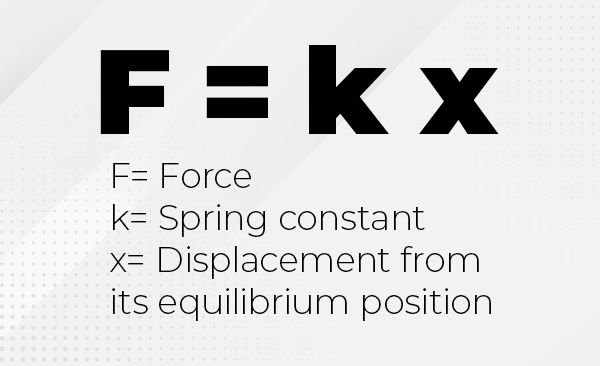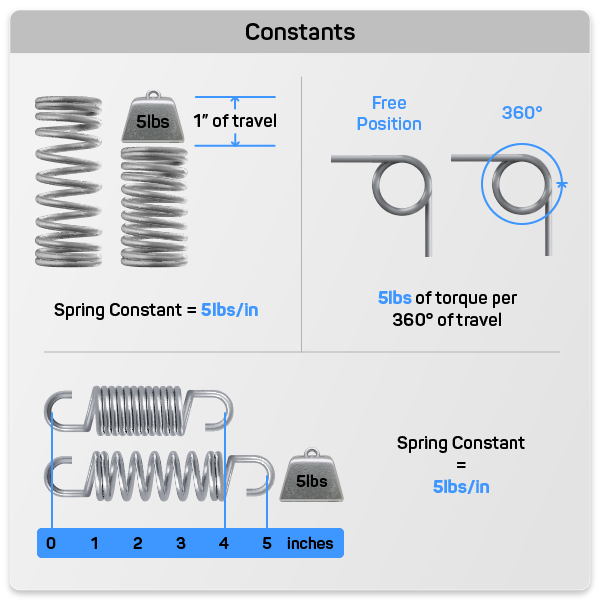Maximizing Efficiency in Machinery Manufacturing: Precision in Spring Constant and Hooke's Law Applications
In the realm of machinery manufacturing, the efficiency and longevity of machines heavily depend on the precise design and application of compression springs. Understanding Hooke's Law is fundamental in this process.
Hooke's Law: A Foundation in Spring Design
Hooke's Law states that the force exerted by a spring is proportional to its displacement. The formula is F=kx, where F is the force, k is the spring constant, and x is the spring's displacement from its equilibrium position. This relationship is fundamental for designing springs that meet precise load and displacement specifications.


The Spring Constant and Its Calculation
The spring constant, k, is determinant in the spring's behavior. Precisely calculating k is essential for the spring's proper performance. Tools like "Spring Creator 5.0" facilitate this calculation, ensuring accurate and reliable designs.
Consistency and Precision in Spring Constant
The spring constant, k, is a critical factor in spring manufacturing. Its accuracy determines the reliability and safety of the component in machinery. For compression and tension springs, k is calculated using the formula k= Gd4/8D3n, where G is the material's modulus of rigidity, d is the wire diameter, D is the mean diameter of the spring, and n is the number of active coils.


Torque and Deflection Verification in Torsion Springs
Similarly, in torsion springs, the verification of torque and deflection is essential. The formula T=kθ (where T is the torque and θ is the angle of torsion) helps calculate the force required for a specific displacement, ensuring the efficiency and safety of the spring in its application.
Practical Applications in Machinery Manufacturing
- Suspension and Damping: In vehicles and heavy machinery, springs are essential for absorbing impacts and vibrations. Correct application of Hooke's Law ensures stability and comfort under various load conditions.
- Return Mechanisms: Springs in tools and devices facilitate the return to the original position. Precision in the spring constant ensures efficient operation.
- Force Control in Industrial Equipment: In manufacturing presses and robotics, springs are used to control movements and apply precise forces. Hooke's Law enables the design of springs that withstand mechanical stresses, enhancing efficiency and safety.
3D Modeling and Potential Energy Testing
The Online Spring Force Tester inside Spring Creator gives you 3D spring modeling and potential energy testing which are advanced design aspects within Spring Creator. These techniques allow visualization of your spring and simulation of spring behavior under different load conditions, providing a deeper understanding of their performance in real situations.
Using "Spring Creator 5.0" and the "Online Spring Force Tester" provides engineers with the ability to generate custom spring 3D CAD files quickly so users can prove a particular design fits in their product. Users design and validate springs, accurately applying Hooke's Law to meet performance and safety criteria.
Industry Case Studies
- Automotive Industry: Optimizing suspension springs for different vehicles exemplifies the importance of correctly applying Hooke's Law to improve stability and control.
- Heavy Machinery: In equipment like cranes and excavators, designing springs to withstand extreme loads is crucial. Applying Hooke's Law to calculate load capacity is essential to prevent material fatigue.
Advanced Tools and Technologies: Spring Creator 5.0
For spring design and verification, the use of advanced tools like "Spring Creator 5.0" is recommended. This online tool allows for efficient and accurate calculation of spring parameters, including spring constant, maximum load, and deflection. Its use facilitates design validation, ensuring that the springs meet the specific requirements of each application.
Challenges in Spring Design
- Material Fatigue: Material fatigue is a significant challenge, requiring a design that considers repeated stress and compression cycles.
- Environmental Conditions: Factors like temperature and corrosion affect spring performance, making it crucial to consider these variables in the design.
- Dynamic Loads: In applications with dynamic loads, it is essential to design springs that can handle these conditions without failure, applying Hooke's Law while considering variable loads.
Hooke's Law is fundamental in spring design for machinery manufacturing. Its correct application, along with advanced tools like "Spring Creator 5.0", allows for the design of springs that meet technical specifications and ensure maximum safety and reliability in critical applications.






